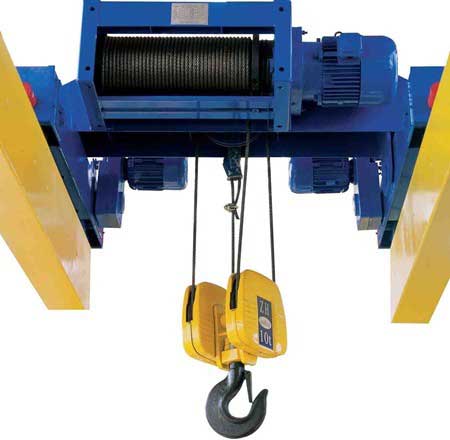lifting crab of a EOT crane
The lifting crab of a EOT crane is an independent two motion machine and consists of the hoist machinery built on to a frame, which is mounted on runner wheels, and driven by a motor through suitable gearing. The crab is also known as trolley.
Various designs of crabs, arranged with C.I. side frames, mild steel side frames are in use. But now a days, preference is given to the built up side frames on which the machinery is mounted.

The function of the crab is to provide cross travel motion to the hoisting machinery along the length of the main bridge of the crane. The entire hoisting machinery is mounted on the crab which moves on runner wheel over rails fitted on the main bridge of the crane.
The motion of the crab is derived from an electric
motor. A speed reduction gear box and a brake are the essential
components of a crab gearing. The motion of the motor is transmitted
through the reduction gear box via the brake. The HP of motor is
calculated by the formula:
W=total load of the crane including the dead load any pay load in tons;
S=Speed of the longitudinal motion in meter per minute;
C=Tractive effort in Kg per ton.
The reduction gear box is designed to obtain a speed ratio which can reduce the motor RPM to the appropriate RPM of the crab runner wheel to produce the desired speed of the crab. The reduction ratio per stage of the gearbox is fixed at 4 to 5 and is the same for all stages.
Relative FAQ
- Lifting crab of a EOT crane, designs of crabs
- Mini crawler cranes
- Rule about marking rated capacity of crane
- Articulating Jib Cranes
- Self-Raising Tower Crane
- Wind and Tower Cranes
- Electric Overhead Travelling Crane (EOT Crane) Parts
- Wall Traveling Jib Cranes
- Classification of Crane Anti-sway devices
- Workstation Jib Cranes

Email: sales@bossbuyer.com
Skype: bossbuyer
Market Hotline
0086-21-61435-919
Service Hotline:
0086-21-61435-919
